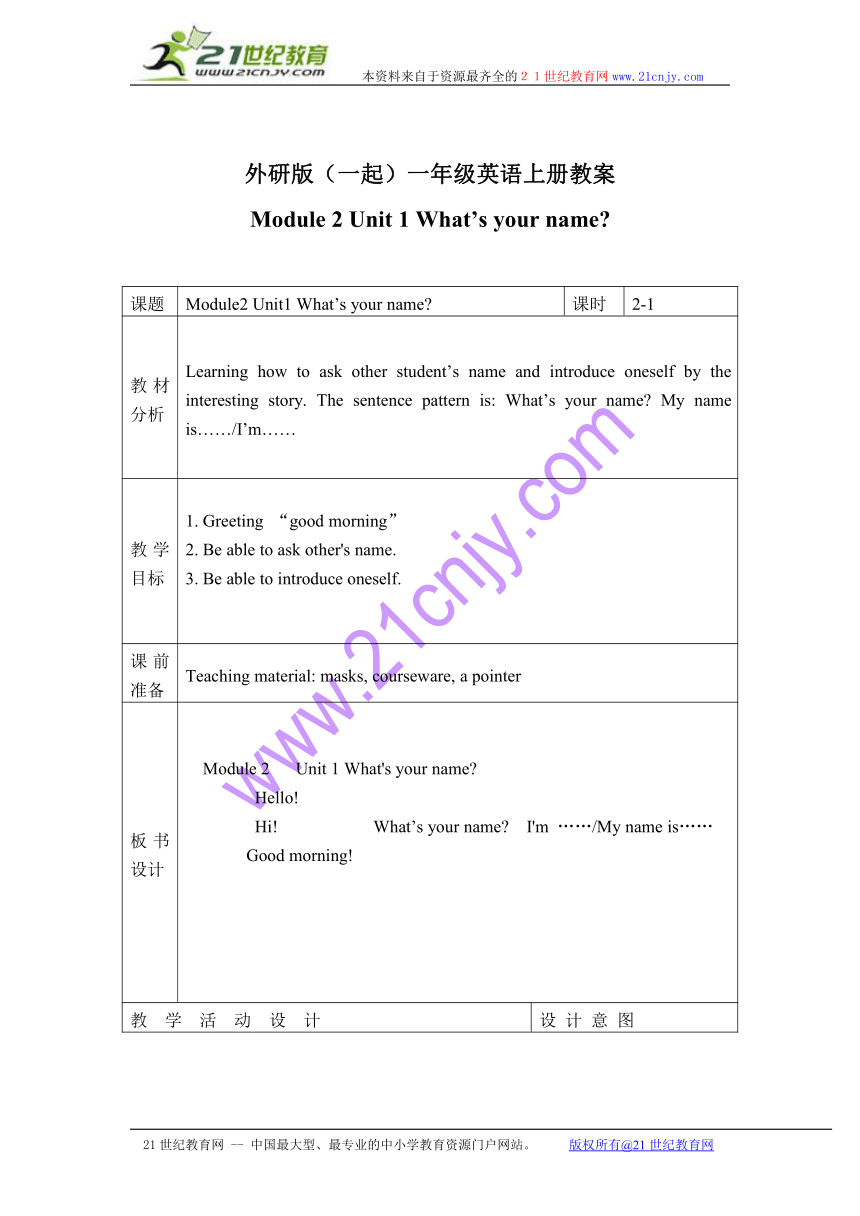外研版(一起)一年级英语上册教案 module 2 unit 1(2)
文档属性
| 名称 | 外研版(一起)一年级英语上册教案 module 2 unit 1(2) |

|
|
| 格式 | rar | ||
| 文件大小 | 13.1KB | ||
| 资源类型 | 教案 | ||
| 版本资源 | 外研版(一年级起点) | ||
| 科目 | 英语 | ||
| 更新时间 | 2009-12-14 20:09:00 | ||
图片预览

文档简介
本资料来自于资源最齐全的21世纪教育网www.21cnjy.com
外研版(一起)一年级英语上册教案
Module 2 Unit 1 What’s your name
课题 Module2 Unit1 What’s your name 课时 2-1
教材分析 Learning how to ask other student’s name and introduce oneself by the interesting story. The sentence pattern is: What’s your name My name is……/I’m……
教学目标 1. Greeting “good morning”2. Be able to ask other's name.3. Be able to introduce oneself.
课前准备 Teaching material: masks, courseware, a pointer
板书设计 Module 2 Unit 1 What's your name Hello! Hi! What’s your name I'm ……/My name is…… Good morning!
教 学 活 动 设 计 设 计 意 图
Warm-up 1. Greeting : Teacher says “Hello, Hi, How are you?” enthusiastically to all students. And expects and encourages their answers2. Let's sing a song with TPR.Revision 1. Free talk2. Perform the dialogue together. Presentation and drills1. Teacher puts on the mask of Ms Smart and says “Good morning” .Shakes hands with a student and saying “Good morning, I’m Ms Smart. Then let the student imitate to say. After that, say it by their true names.2. Let students watch the courseware carefully and answer questions about the story.(let them know “bird”)3. Practice in a chain. (What’s your name I'm……/My name is……)4. Reading the story with some gestures.Practice1. Listen to the cassette and repeat it.2. Group co-operation: Ask a group to perform the story in the front of the classroom. Let’s see who the best is.Consolidation and extension1. Practice the sentences in pairs.2. Finish exercises on the activity book.3. Sing a new song: Hi, Hello, What’s your name Hi, Hello, What’s your name Hi, Hello, What’s your name I’m Amy. My name is Amy. Try to motivate the interest of all students and to be attentive at the beginning of the class. Several games in the class can attract the attention of students. Let them practice in an interesting way. Taking advantage of body language is to give students a deep impression of our contents. And make students interested and gain more confidence. The lyric make students to remember the sentences and its usage easier.
作 业设 计 1. Perform the story for your parents.2. Talk to your parents(Ask your parents’ names)Sing the song we’ve learnt today.
教 学反 思 在课文的学习中,TPR活动运用其中,使孩子在看到动作后都能熟练的说出课文,比单纯的背要有趣得多,而且记忆更深刻。在认读方面,我强调孩子要用手指读,再用铅笔圈出“What’s your name ”,同位之间互相检查。在上了这几个星期的课,我发现板书对孩子的认读很重要,即使一年级的孩子不认识。但清楚的写在黑 板上对孩子确实有潜移默化的影响,使孩子对认读有了认识基础,所以在今后的教学中,我还要好好考虑怎样才能让板书发挥其更大的功效。
21世纪教育网 -- 中国最大型、最专业的中小学教育资源门户网站。 版权所有@21世纪教育网
外研版(一起)一年级英语上册教案
Module 2 Unit 1 What’s your name
课题 Module2 Unit1 What’s your name 课时 2-1
教材分析 Learning how to ask other student’s name and introduce oneself by the interesting story. The sentence pattern is: What’s your name My name is……/I’m……
教学目标 1. Greeting “good morning”2. Be able to ask other's name.3. Be able to introduce oneself.
课前准备 Teaching material: masks, courseware, a pointer
板书设计 Module 2 Unit 1 What's your name Hello! Hi! What’s your name I'm ……/My name is…… Good morning!
教 学 活 动 设 计 设 计 意 图
Warm-up 1. Greeting : Teacher says “Hello, Hi, How are you?” enthusiastically to all students. And expects and encourages their answers2. Let's sing a song with TPR.
作 业设 计 1. Perform the story for your parents.2. Talk to your parents(Ask your parents’ names)Sing the song we’ve learnt today.
教 学反 思 在课文的学习中,TPR活动运用其中,使孩子在看到动作后都能熟练的说出课文,比单纯的背要有趣得多,而且记忆更深刻。在认读方面,我强调孩子要用手指读,再用铅笔圈出“What’s your name ”,同位之间互相检查。在上了这几个星期的课,我发现板书对孩子的认读很重要,即使一年级的孩子不认识。但清楚的写在黑 板上对孩子确实有潜移默化的影响,使孩子对认读有了认识基础,所以在今后的教学中,我还要好好考虑怎样才能让板书发挥其更大的功效。
21世纪教育网 -- 中国最大型、最专业的中小学教育资源门户网站。 版权所有@21世纪教育网
同课章节目录
- Module 1
- Unit 1 Hello?
- Unit 2 How are you?
- Module 2
- Unit 1 What's your name?
- Unit 2 I'm a boy
- Module 3
- Unit 1 Sit down!
- Unit 2 Point to the window!
- Module 4
- Unit 1 It's red
- Unit 2 It's a red dog
- Module 5
- Unit 1 This is our teache
- Unit 2 This is a yellow cat
- Module 6
- Unit 1 What's this?
- Unit 2 It's my rule
- Module 7
- Unit 1 Is it a dog?
- Unit 2 It's a yellow cat
- Module 8
- Unit 1 How many?
- Unit 2 How many pink balls?
- Module 9
- Unit 1 How old are you?
- Unit 2 Happy birthday!
- Review Module
- Module 10
- Unit 1 That is my fathe
- Unit 2 That is his ca
